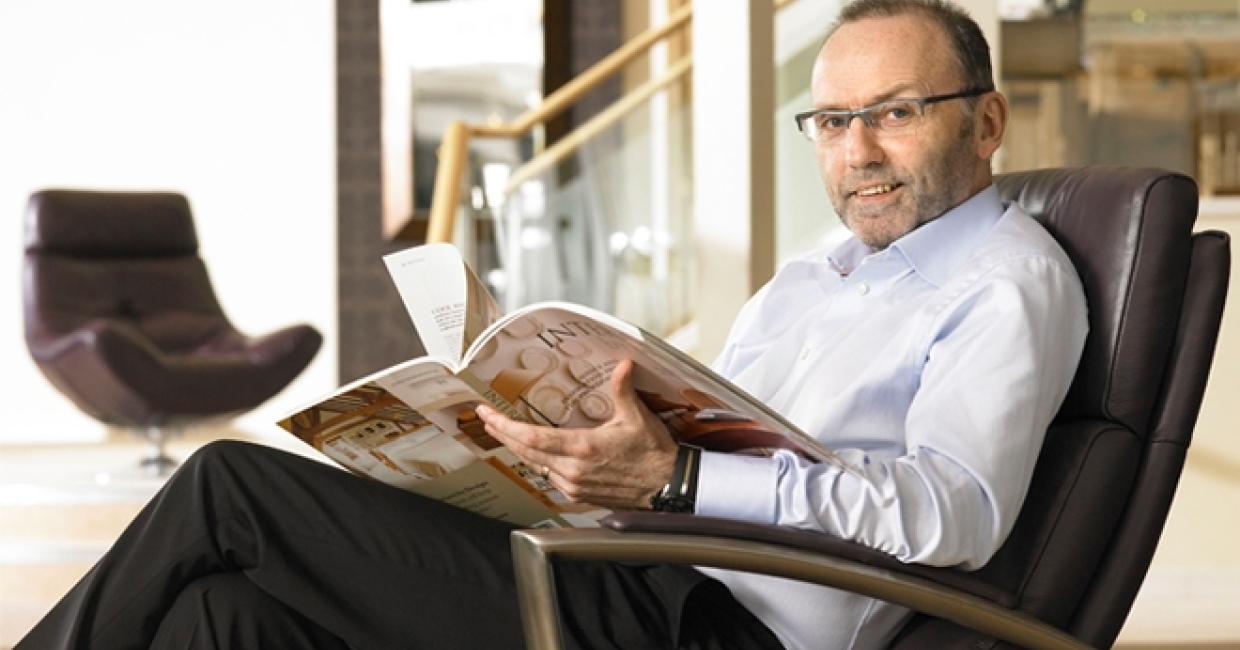Furniture Village is the UK’s largest privately-owned furniture chain. Two years ago, its directors elected to re-invest their profits in the business. Aiming to improve competitiveness while safeguarding against economic downturn, they opened a National Distribution Centre, and invested in a training facility, as well as new and refurbished stores. But how else is the retailer squaring up to today’s marketplace? Paul Farley speaks to buying and development director, Malcolm Walker, to find out …
May 2013 saw the relocation and opening of Furniture Village’s flagship Croydon store, its largest to date at 40,000 sqft. A further store was opened in Ipswich last month, taking the number of outlets to 40. In a recent interview with The Business Magazine, the company’s founder Peter Harrison remarked: “You’ve got to fight out there, the market is incredibly tough.”
Furniture Village appears to be doing everything it can to ensure it remains on top, and product selection and store presentation play no small part in its strategy. Responsibility for these areas falls to buying and development director, Malcolm Walker. “It’s my job to bring products to life,” he says.
Malcolm has spent 37 years in home furnishings retail. He spent his early years in Newhouses in Middlesbrough, a family-owned department store, before moving into group buying and store management for Maples. To date, he has spent 15 years with Furniture Village, as a buying controller and director, before being appointed to his current position in 2008. During that time, Malcolm has seen Furniture Village reach outwards from a predominantly UK supply base to become a global player.
Malcolm is responsible for product direction – sourcing suppliers, styles, better value and, critically, new product categories – as well as ensuring the most commercial and relevant layout of the store showrooms.
“In my opinion it’s the best job in the industry,” he says. “My favourite part of the job, without a doubt, is developing great new product, and making it look good in store – there’s no better feeling than when the customers respond well.”
I catch up with Malcolm a few days before the company’s 24th birthday – alongside annual promotions, customers are treated to drinks and cake to celebrate the occasion. He has just returned to the company’s Slough headquarters after visiting the new store in Ipswich. Although much smaller than Croydon, it boasts all the design elements of the flagship, as well as a few new touches.
In setting a new standard, the flagship has already proved its worth. “By nature, we are quite a cautious business,” says Malcolm, “but we’ll take advantage of opportunities when they are there – such as the relocation and expanding of the Croydon store. It’s enabled us to do lots of things – we’ll put every single new idea in there to test, and then cascade their success downwards. It’s created a bit of excitement, both internally and externally.”
“By nature, we are quite a cautious business, but we’ll take advantage of opportunities when they are there”
While conducting my own reconnaisance of Furniture Village stores in the South-east, I’ve noticed some of the shared characteristics that unify the brand. “We’ve a pretty sound method of laying out the showroom,” says Malcolm, before displaying a detailed awareness of the specifics of each location.
“The original concept of Furniture Village was a collection of niche stores under one roof,” he explains, “and we put similar products – beds, upholstery, dining, etc – together so the customer can make an informed choice.”
With all-in-one roomsets proving popular these days, I ask what prompted Malcolm to continue to segregate the stores’ offering. “If you create an absolute roomset, I think people tend to stand on the outside, looking in,” he says. “We want customers more involved, so our displays are more suggestive, than room sets per se.” There’s also, he adds, the likelihood of discontinued items over time, making the maintenance of said roomsets at best difficult, and, at worst, unsustainable.
Despite this, floorspace is still carefully accounted for. “We have two-tone carpet in all our stores, which defines walkways and helps the customer journey throughout,” explains Malcolm. “In the vast majority of them, floor displays are laid out on oval islands, with a selection of upholstery in the centre and more around the wall. After all, if you get more than two or three models deep, the customer just ends up looking at a sea of sofas.
“Ultimately, your stores have got to be welcoming, unthreatening, and not too austere, and the customer’s journey through them has to be pleasurable – that’s why we also offer coffee and cookies!”
Well-trained sales staff are vital to delivering this experience, and Furniture Village has invested heavily in this respect, adding a learning and development academy to its Slough store, and bolstering the reach of the training specialists already present at its national distribution centre in Milton Keynes.
“We work closely with our supply base to ensure the best techniques, principally because, with the level of product we sell at, and the geographical areas we sell in, we need to offer right advice. Beds in particular require a good level of technical expertise. People tend to know when they’re buying something that’s right for them – conversely, our staff need the confidence and ability to sell it to them.”
This is particularly true of Furniture Village’s branded stock, much of which occupies the higher-end price brackets. The retailer’s approach to brands is visibly confident – as expected from a retailer that was once straplined ‘the brand leaders’, Furniture Village’s portfolio is a veritable who’s who of leading names – Duresta, ercol, G Plan, Nathan, Old Charm, Vi-Spring, Parker Knoll … and that’s just the British contingent.
“If someone wants to buy a mid-priced or expensive upholstery group, they are going to want to sit on it first. It’s a combination of bricks and clicks for us”
“We are probably the leading customer of many of these brands – we even put some of them closely together so the customers know they are dealing with an authority. There’s a halo effect from those brands to us, and vice versa. The brands we work with are amongst the best in the industry, and the most stable – they have survived the test of time in their current incarnation.
“However,” he continues, “we are always on the look out for things that are not in our portfolio.” As a buyer, Malcolm travels extensively, paying regular visits to both the existing supply base and the world’s leading trade exhibitions. These include Milan, Singapore and Shanghai – the latter principally to keep abreast of the level of work coming out of the factories in the Far East.
“You’ve got to stay as close as you can to everything going on out there,” says Malcolm. “For many years, the hub of our supply base was South Wales and the Midlands – all that changed when Asia entered the market. Of course, there are many fine companies with great practices out there – but we still do a substantial amount in the UK, and we try to support British manufacture whenever we can.”
Source notwithstanding, on the retail side it’s the domestic market that demands the most attention, and in this arena, Furniture Village’s marketing team comes into its own. Whether it is assessing the customer demographic in a potential store catchment, or studying competitors’ approaches to advertising, price points and store layout, the team is vigilant and proactive.
Consideration of customer and advertising opportunities is crucial to the successful roll-out of new stores, says Malcolm – the reason Furniture Village has not yet settled in Scotland, Wales or Northern Ireland is principally because “there’s still plenty more holes on the map to fill if we’re going to make the most of our existing television and advertising regions”.
The online team is a vital part of this marketing mix, ensuring that the retailer communicates effectively with existing customers, and takes advantage of any multi-channel opportunities. “Our web business is very significant,” says Malcolm, “and we intend to double it over the next couple of years.
“However, I can’t see it taking over. If someone wants to buy a mid-priced or expensive upholstery group, they are going to want to sit on it first. It’s a combination of bricks and clicks for us.”
Overall, the picture Malcolm paints is of a retailer that has every angle covered, and does so in its own way – for instance, the unique working relationship between its buyers and internal departments and management team, or its store layout, which “puts the emphasis on people, our greatest asset”.
And, whatever happens next, Malcolm is confident Furniture Village will be ready. “The only thing we can say about the way the market is that it’s tough, but you’ve got to respond to it,” he says. “We are dealing with it creatively, as well as from product presentation, customer service and training angles. The one thing we can’t control is the weather – the sun comes out, and you’ve got to find a way around it. At least we haven’t got the distraction of the Olympics this year – just 30-odd degree heat to contend with instead!
“Basically, you’ve always got to be looking for something new, and presenting it well to the customer. In this business, there’s never time to stop developing.”
This interview featured in Furniture News magazine, issue 294 (September 2013), which can be accessed in the archive here.












